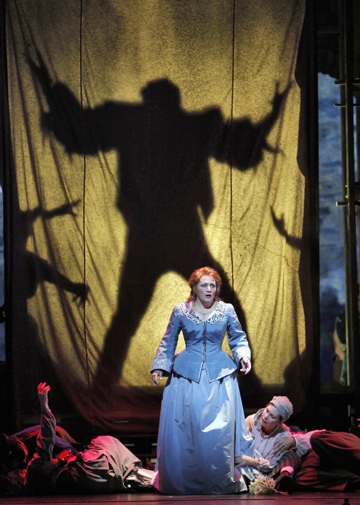
Devilish attractions
Goethe spent some 60 years working on the story of Faust, originally a German folk-tale trickster whose various tales began to solidify into one story at the end of the 16th century. Goethe worked on many versions of the story over those long years, finally settling on two plays, both of which dealt with a problem Goethe struggled with in his own life: that of disappointment with the boundaries of human knowledge.
Gounod and his librettists, Jules Barbier and Michel Carré, made no attempt to stage the complexities of Goethe’s text in their opera. Their Faust begins with the scholar scientist despairing over the limits of his understanding and quickly morphs into a story of seduction and slipped morality. As such it becomes more of a cautionary tale for young women: “Don’t open the door until you have a ring on your finger”!
The opera ends with both a damnation (Faust’s) and a resurrection to faith (Marguerite’s)—something for everyone.
The San Francisco Opera’s current production of Gounod’s Faust, which opened Saturday evening, June 5, is traditional in its concept: the setting is in 19th century Germany, with huge representational sets of buildings and interiors lit in blues and shadows, though neither so ominously deep or extreme in perspective as to conjure up visions of de Chirico or other artists of mystery. Robert Perziola was the production director for this production that originated with the Chicago Lyric Opera.
Sing for your soul
The singers are excellent. And most, with the exception of tenor Stefano Secco (Faust) and baritone Brian Mulligan (Valentin), are or have been participants of the Adler and Merola programs.
Patricia Racette, and there is a case to be made that the opera should be called Marguerite rather than Faust, seems especially well-suited to the role of the innocent woman who loses her body and nearly her soul to the sin of passion. With enough dramatic heft and complexity to her voice, she navigates Gounod’s score with ease and grace. There is an earthiness—a solidity—to Racette’s stance as a singer that favors her portrayals of fallen yet devout women.
Stefano Secco’s voice, while not as brightly resonant as many Italian tenors, is refreshing in its timbre and, overall, just lovely. Brian Mulligan gave an impassioned and appropriately vigorous portrayal of Valentin. And Daniela Mack was boyish and eager as Siebel.
The singer who got the largest cheer from the audience was bass-baritone John Relyea, a tall, attractive man with a decorous stage presence and a mighty big voice capable of dropping to Stygian depths. When all is said and done, isn’t the devil the one we love the best, really? Relyea made it easy.
Director Jose Maria Condemi tried to navigate the complexity suggested by Goethe’s original with a series of devices that at times worked and at other times pointed out the melodramatic foibles of the opera’s reductive story. His stop-action moments enhanced by changes in lighting during the soldiers’ chorus in the first act were interesting but somewhat incomprehensible and had no counterpart throughout the rest of the opera.
Condemi makes the devil a darkly comic role—ably assisted in the second act by mezzo-soprano Catherine Cook’s Marthe—and it is here that he seems most directorially happy. There is lightness and vitality in his comedy, even though it occasionally lapses into the silly, such as when the devil covers the eyes of the statue of Virgin so that she doesn’t see Faust’s seduction of Marguerite. The more dramatic moments of the opera were often too gestured and melodramatic. The soldiers’ homecoming, embellished by dying soldiers and the presentation of flags to the surviving families seemed fussy. The music is sufficient.
Maurizio Benini made his San Francisco Opera debut as conductor, and except for a slight slowness in the opening overture that was meant to evoke somberness and the darkness of hell, the orchestra was sounding its usual superlative self.
—Jaime Robles
Also published in the Piedmont Post
Photo: Patricia Racette as Marguerite by Cory Weaver
